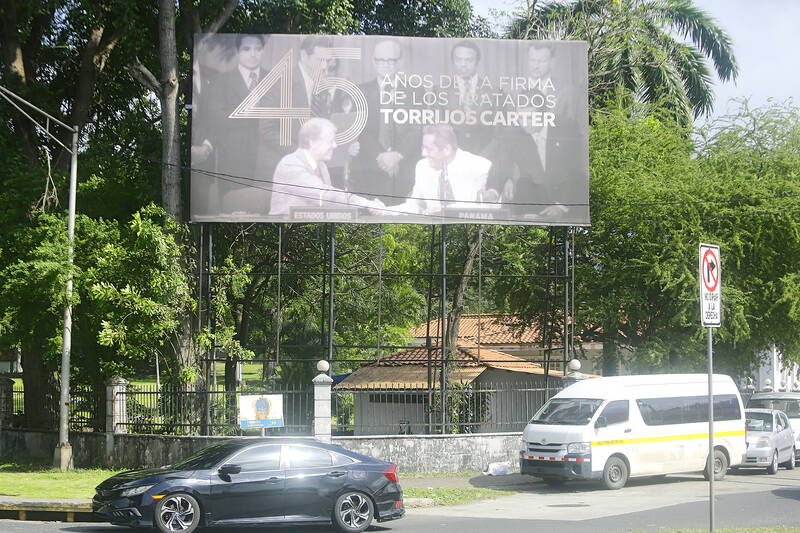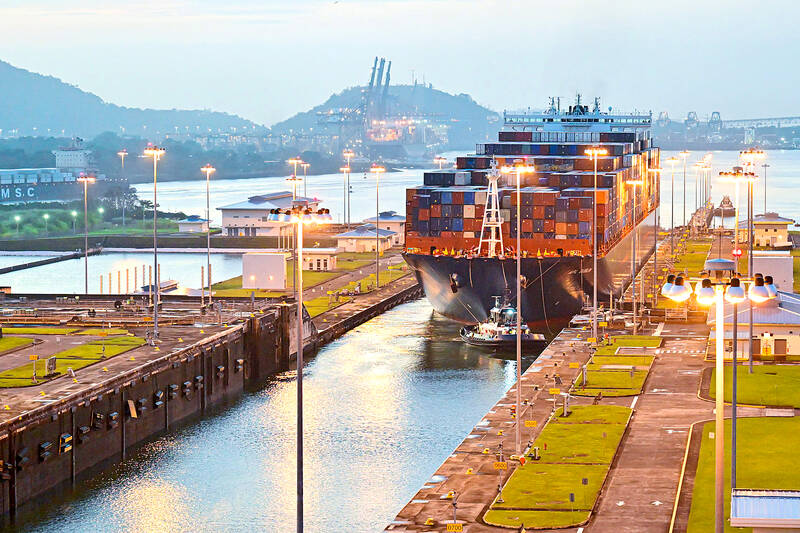US President Donald Trump’s bid to take back control of the Panama Canal has put his counterpart Jose Raul Mulino in a difficult position and revived fears in the Central American country that US military bases will return.
After Trump vowed to reclaim the interoceanic waterway from Chinese influence, US Defense Secretary Pete Hegseth signed an agreement with the Mulino administration last week for the US to deploy troops in areas adjacent to the canal.
For more than two decades, after handing over control of the strategically vital waterway to Panama in 1999 and dismantling the bases that protected it, Washington has regularly conducted maneuvers in the country.

Photo: EPA-EFE
WILL US BASES RETURN?
Although the agreement does not allow the US to build its own permanent bases, Washington will be able to maintain a long-term rotational force in Panama, similar to the one it has in Australia and other countries, for training, exercises and “other activities.”
The US will be able to deploy an unspecified number of personnel to three bases that Washington built when it previously had an enclave in the canal zone.

Photo: AFP
That is a “flagrant violation” of the constitution, which prohibits foreign bases, and the 1977 handover treaties that establish the “neutrality” of the canal and permit only Panama to have military forces on national territory, said Euclides Tapia, a Panamanian professor of international relations.
But there is a loophole: one of the treaties “allows the US to defend the canal when it feels the neutrality is jeopardized,” said Will Freeman, an expert at the Council on Foreign Relations, a US-based think tank.
Benjamin Gedan, former director for South America on the US National Security Council, argues that Panama has cooperated with the US in securing the canal. Panamanian lawyer Arturo Hoyos sees no violation of laws or treaties, as the new agreement allows “joint” operations.
MULINO IN TROUBLE?
Mulino’s government says that the facilities and land belong to Panama and will be for “joint use” by US and Panamanian security forces.
He maintains that he has not ceded an inch of sovereignty to Trump, a natural right-wing ally.
The agreement is a “trade-off” because it “limits the Trump administration’s pressure tactics and hostility and maybe the scope of the concessions” by Panama, Freeman said.
“The risk that nobody’s pricing in, at least on the US side, is that they make Mulino a lame duck” by humiliating him, leaving the Panamanian leader “unable to govern,” he added.
Former presidential candidate Ricardo Lombana accused Mulino of “camouflaging” military bases and disguising “surrender” as “cooperation.”
“The United States is recolonizing and reoccupying us,” said Julio Yao, who advised the Panamanian government in the 1977 negotiations.
Gedan, a professor at Johns Hopkins University, believes Panamanians “are not willing” to allow the return of US bases due to the trauma of the past occupation of the canal zone and the 1989 US invasion to overthrow dictator Manuel Antonio Noriega.
WHAT DOES TRUMP WANT?
The US considers a Hong Kong company’s operation of ports at both ends of the canal to be a threat to its national security.
“Trump wants to minimize the risk of Beijing blocking the canal to prevent the passage of military vessels in a potential conflict,” Gedan said.
Natasha Lindstaedt, an expert at Britain’s University of Essex, sees the US moves as “part of a larger conflict with China as the US is trying to curb China’s influence in Panama and the region more generally.”
Freeman said that the Trump administration “most likely is trying to show that if it wanted to, it could close the canal to Chinese commerce as a way of exerting pressure on China, either not to invade Taiwan or in the event of a conflict over Taiwan.”
“What we’re seeing in Panama is also about Trump’s doctrine of peace through strength,” he said.
But Tapia was skeptical that China really poses a threat, suggesting the threats were aimed at boosting Trump’s domestic support.
“Canada becoming part of the United States or saying that they will take over the canal and Greenland is just a gimmick aimed at the American public,” he said.

April 14 to April 20 In March 1947, Sising Katadrepan urged the government to drop the “high mountain people” (高山族) designation for Indigenous Taiwanese and refer to them as “Taiwan people” (台灣族). He considered the term derogatory, arguing that it made them sound like animals. The Taiwan Provincial Government agreed to stop using the term, stating that Indigenous Taiwanese suffered all sorts of discrimination and oppression under the Japanese and were forced to live in the mountains as outsiders to society. Now, under the new regime, they would be seen as equals, thus they should be henceforth

Last week, the the National Immigration Agency (NIA) told the legislature that more than 10,000 naturalized Taiwanese citizens from the People’s Republic of China (PRC) risked having their citizenship revoked if they failed to provide proof that they had renounced their Chinese household registration within the next three months. Renunciation is required under the Act Governing Relations Between the People of the Taiwan Area and the Mainland Area (臺灣地區與大陸地區人民關係條例), as amended in 2004, though it was only a legal requirement after 2000. Prior to that, it had been only an administrative requirement since the Nationality Act (國籍法) was established in

Three big changes have transformed the landscape of Taiwan’s local patronage factions: Increasing Democratic Progressive Party (DPP) involvement, rising new factions and the Chinese Nationalist Party’s (KMT) significantly weakened control. GREEN FACTIONS It is said that “south of the Zhuoshui River (濁水溪), there is no blue-green divide,” meaning that from Yunlin County south there is no difference between KMT and DPP politicians. This is not always true, but there is more than a grain of truth to it. Traditionally, DPP factions are viewed as national entities, with their primary function to secure plum positions in the party and government. This is not unusual

US President Donald Trump’s bid to take back control of the Panama Canal has put his counterpart Jose Raul Mulino in a difficult position and revived fears in the Central American country that US military bases will return. After Trump vowed to reclaim the interoceanic waterway from Chinese influence, US Defense Secretary Pete Hegseth signed an agreement with the Mulino administration last week for the US to deploy troops in areas adjacent to the canal. For more than two decades, after handing over control of the strategically vital waterway to Panama in 1999 and dismantling the bases that protected it, Washington has